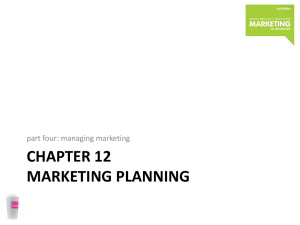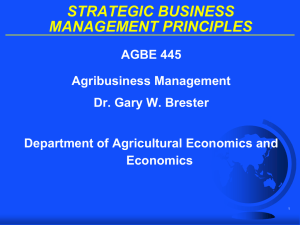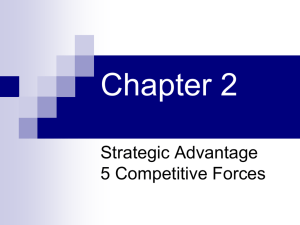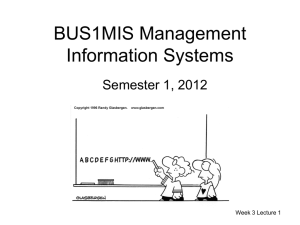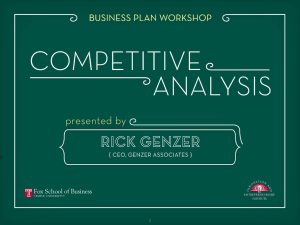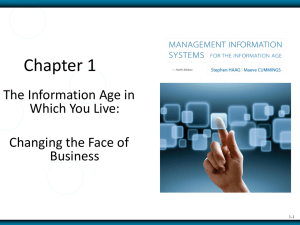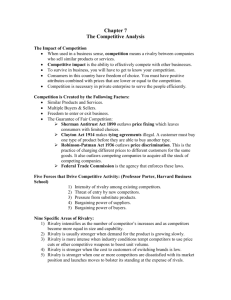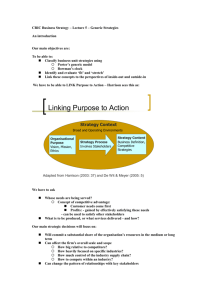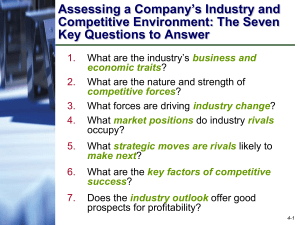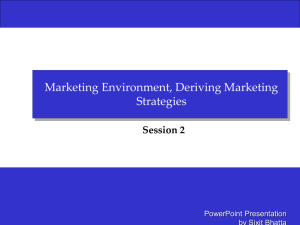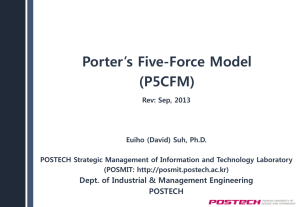Industry Dynamics and Change Presentation
advertisement
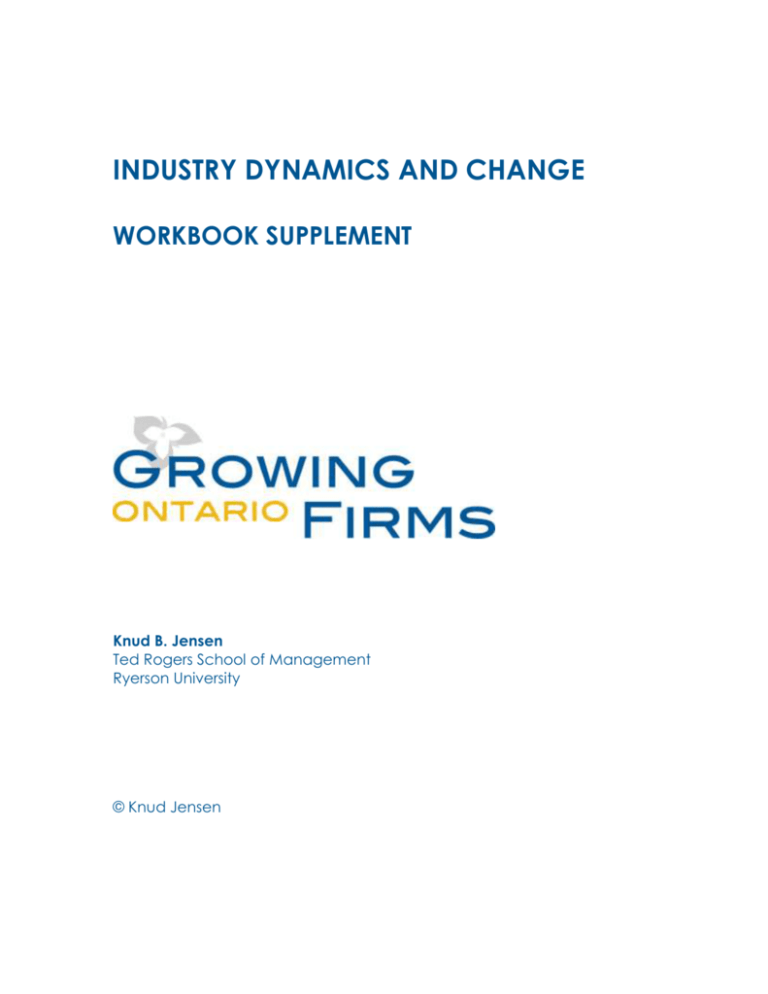
INDUSTRY DYNAMICS AND CHANGE WORKBOOK SUPPLEMENT Knud B. Jensen Ted Rogers School of Management Ryerson University © Knud Jensen The Changing Role of Information in the Strategic Development Process A company’s strategy development is built on a solid base of information that provides the knowledge platform for the development of business strategy and the execution of the strategy. Without information, a company cannot undertake a strategy development process. Information provides managers with the insight and depth of understanding to make decisions. Information clarifies complex issues and defines the landscape in which the organization operates. Once the landscape is clarified, a map for the future can be drawn up by the company. The information that an organization needs for strategy development can be divided into two areas: information about the external environment and information about the internal environment. Both are equally important in developing insight and understanding. Information acquisition also constitutes reality checks. All managers develop pet theories of how the market works or how well the employees are engaged. These ideas must be tested against the current reality. Strategy is the direction a company decides to take, a road map to the future. As the Queen said to Alice in “Alice in Wonderland”(1): If you don’t know where you want to go any road will do.” For an organization’s future, it is extremely important to select the right road to make the right competitive moves, and invest in the right future position. 1 Companies must address three questions: Where am I? Where do I want to go? How do I get there? A good knowledge and information platform is an essential starting point for a discussion of these important questions. We have more information available now than ever before, almost too much. The question used to be…where do I get information to support the strategy? Now it is…how do I sift through the information and select the relevant points? What is needed is a device that will allow you to sort out the relevant from the irrelevant. Peter Drucker(2), the well-known management guru, talked about “apparent knowledge” as a description of the volume of information faced by today’s managers. He suggests that some of the information is relevant and some is not. All information is not equal, and Drucker also suggests that intuition and judgment play a key role in screening for relevant information. Business schools have always played up fact-based information as a base for decision-making, belittling intuition, judgment, and visceral input which are based on the experience of the manager. But with the unevenness of information, sound judgment comes to the fore. Not only do we have volumes of information available to support decision-making, but we also have information that is volatile and changes quickly. The assumption of the stability of information is long 2 gone, making it much more difficult to build a stable strategy knowledge platform that can guide the strategy decision-making process. The mitigation of risk has become even more difficult for strategists. Instead of the information itself being of importance, the real importance lies with the manager who screens the volume of information and makes assumptions about value, importance and relevance. Of utmost importance are the manager’s assumptions about the external and internal environment of the organization. This mental model filters and interprets, and strategy is often based on this filtered data. The mental model is the screening device that helps managers simplify complex pieces of information from markets, industry, competitive reactions, etc. Mental models take information and simplify it for daily use. Beliefs (the substance of mental models) about how to manage a business and the impact of the external environment affect the use and interpretation of information and subsequently strategic choices about which road to take. For example, I recently spoke with a CEO who felt that the Canadian and US economy was deteriorating rapidly. His speech to the employees on the strategy of the organization was peppered with such phrases as “batten down the hatches, cost-cutting, only low-risk investment, preserve the bottom line.” One of the outcomes was that the company dropped a line of products currently in the research and development stage. This company’s current strategy is a mix of defensive activity and 3 retrenchment. All information was screened through the CEO’s mental model of the next two to three years. The assumptions held are the glue that holds the strategic knowledge platform together, and on which the near future of the company is built. Now, we need to understand the information and the mental model of the manager who interprets the information, in order to get closer to the organization’s internal and external realities. The Navajo have a philosophy which states that “you need to be in harmony with reality”; an excellent piece of advice for any manager or CEO. 4 Type of Information Needed to Build the Strategic Platform The Sandbox Before seeking out information it is important to agree on what the boundaries are for the space you are competing in. You need a set of parameters within which you collect data. What sandbox is your company playing in? For example, Whole Foods(3) is an organic food retailer. Do they compete in the organic food sector or the general food retail industry? They are a big fish in one sector, and a small fish in the other. Data collection and metrics such as market share will differ depending on the choice of space. Nexity(4), a US virtual bank, had to decide whether they competed in the online market (2% of the total banking market) or the large banking market inhabited by the giant brick and mortar banks, such as Citigroup, with US$1 trillion in assets versus Nexity’s US$500 million in assets. Your space assumptions affect not only data collection, but also analysis and strategy. The information gathered must be relevant to the organization’s environment and competitive position, not an exercise in searching for general economic, politicallegal, and sociocultural trends. Some of these factors may be brought in if they impact on the company’s future, but a general analysis is of little value to the strategist. 5 The objectives of the information must always be kept in mind: 1. To develop a deep understanding of where the company is now with respect to the external environment. 2. To clarify the complex forces impacting on the company. Thompson, Gamble and Strickland, in their book, Strategy – Core Concepts, Analytical Tools and Readings(5), suggest that companies must think about the external and internal environments and answer the following direction-shaping questions, based on information gathered. Externally Focused Questions: How and at what pace is the company’s market environment evolving? What factors are driving market change and what impact will they have? What are competitors up to? In what ways are competitive conditions growing stronger or weaker? What does the changing market and competitive landscape mean for the company’s business over the next five years and beyond? What new markets and customer groups should we be moving in position to serve? What should we abandon? Internally Focused Questions: What are our ambitions for the company? What industry standing do we want the company to have? What organizational strengths should we be trying to leverage and what weaknesses do we need to correct? 6 Will our present business generate adequate growth and profitability? What new products/services (or businesses) do we need to add? What new capabilities do we need to be successful in the marketplace of the future? If you answer these questions you are well on your way to understanding where the company is currently. Key Information Information on the Industry or Market The industry and the market may be the same, or the market may be a part of a larger industry, or there may be several markets that belong to very different industries. For example, a company selling laser cutters may have several markets such as the engraving market, the plastic gift market, the sample market, and the binder market. These are vertical markets. Geographically, they may sell to the US via distributors and sell direct in Canada. There are layers of complexity in most markets. What we need to know is the size and historical (two to five years) growth in the market/industry. We may want to position the industry/market as starting growth, maturity, or decline (life cycle). We need to understand magnitudes, market limitations, and prospects for the future. For example, if we look at the golf industry we will observe a decline. This suggests that new sales may have to come from current competitors (expensive), or we may consider moving into related products such as golf clothing. A lot of 7 discussion can be generated from looking at simple growth trends. Within the industry/market, key segments must also be identified. Industry Structure Is this an industry dominated by one or two companies, such as the generic drug industry in Canada, or is it an industry comprising a large group of mid-sized companies? If viewed on a historical basis, the structure will also provide information on consolidation trends. For example, the steel industry world-wide is in a consolidation phase; companies are seeking scale in order to reduce costs. The industry structure should be looked at from both a demand (buyers) and a supply (competitors) point of view. Looking at the liquor industry in Ontario, we find there is only one buyer for wine, a monopoly called the LCBO. If Diageo single malt scotch is not carried by the LCBO retailer, they will not be able to sell their product in Ontario. This is a different industry structure than in the US and the UK where private retailers sell alcoholic beverages. The industry structure impacts heavily on our business strategies. Geographic structure will also need to be looked at since we have seen that different geographic jurisdictions have different structures. 8 Competitors and their Markets A listing of key competitors, their market share and markets – this is a quick view. Later, a full analysis will be made. Buyer Profile This is a start to a buyer analysis (business, consumer, and channel – value chain). List the characteristics of the buyer and the requirements for suppliers. For example, with the laser cutter market, is price important? If price is important, a low-cost, standard machine may be a product offering to be considered. It is important to note that a distributor’s requirement in a vertical market may be very different from the end user’s requirements. Role of Technology Technology creates or destroys markets. In certain industries it is the stand-out issue, in others it is a much lower priority. It is important to understand the particular role that technology plays. Where do the industry and your competitors stand on technology? It may be worthwhile to compare R & D expenditures in the industry. 9 Entries and Exits A quick look at recent entries and exits will often provide useful insight. Products This is a comparison of industry products, along with variables such as the length of the product cycle and the scope of product introductions. Some consumer industries find themselves with a large percentage of their products that did not exist a year or two previously. Others see the same product offering for a decade. For example, compare laundry bleach with cell phones. In Practice A lot of the previously discussed information may be known to a company, but the information may reside in various places and with different persons. It is important that it be centralized in a document that can be discussed by various managers. This discussion will then become a part of the company’s knowledge base and the group’s collective mental model. This information is the beginning of the sense-making process that must take place before any strategy discussions. Developing a common, shared mental model is part of the underlying process of strategy development. 10 Analysis of Information Driving Forces Driving forces are variables that have the capacity to change not only demand, but also the very nature of an industry. It is extremely important to identify and be aware of these forces. The driving forces often result in change in industry structure, product portfolio, competitive reaction, and basic buyer behaviour. Some driving forces are slow, such as the aging of the population (demographics), and others are quick, such as a new technology or product, which immediately makes current products obsolete. The company not only needs to identify the forces, but also evaluate the impact they will have on the company and the industry. Clayton M. Christensen(6), in his book “The Innovator’s Dilemma”, has labeled some of these drivers as “disruptive technologies”. He illustrates this with Sears, who completely missed or ignored discount retailing and home centres. Eaton’s completely missed the change in buyer behaviour. There are two issues here for the company: (1) missing the boat; and (2) failing to deal with the change. Responding to change and making good decisions are at the heart of strategy. Christensen’s book is about how managers can understand what changes are taking place, what has caused these changes (root causes), and what it will take to address the changes. Christensen sets out five principles for management: 11 1. Companies depend on customers and investors for resources. They influence how money will be spent by the firm. 2. Small markets don’t solve the growth needs of large companies. 3. Markets that don’t exist can’t be analyzed (market research has its limits). 4. An organization’s capability defines its disabilities and therefore the growth. This becomes a serious implementation issue. The market may beckon, but the company does not have the resources to take advantage. 5. Technology supply may not equal market demand. Technology often moves at such a rapid pace that it gets ahead of the market. The driving forces most commonly encountered include: 1. Demographics 2. Technology 3. Innovations, inventions 4. Social and cultural changes 5. New products/services 6. Changes in buyer attitude 7. Government regulations, policy, changes in law Map Making Maps are great tools for understanding a company’s position in an industry. Karl E. Weick, in “Sensemaking in Organizations”(7), tells the story of a small group of soldiers who became lost in a snow storm in the Swiss Alps during a military maneuver. They were totally lost until one soldier 12 found a map in his pocket. This discovery reassured the group. They waited until the snow storm subsided, and using the map to get their bearings, returned safe and sound. When the head of the unit looked at the map, it was discovered to be a map of the Pyrenees in Spain and not the Alps in Switzerland. Weick raised the possibility that when you are lost, “any map will do”, or “if you are confused, any old strategy will do.” Strategies are maps of the future for an organization. They help managers understand relationships among companies in the same industry. They build theories of action that lead to trial and retrial and to the accumulation of knowledge. In this manner, the organization develops harmony with reality. Maps range from the simple to the complex. The manager’s map is a simple, two-variable map with companies located in their perceived space. The difficulty is always in selecting the two axes. Sometimes companies are depicted by a circle approximating their size. Keep in mind that this is a perceptual map and agreement on position is important. Some axis labels are more fact based, such as the number of locations versus price, whereas others are more perceptual, such as quality versus buyer image. Several maps can be drawn with different axes to provide deeper insight. You can also bundle companies that are similar. Once the map is drawn, the strategist can plot expected moves 13 and the migration of companies. For example, in the automobile industry, in the last decade, Saab has migrated from a utility automobile known for winning rally races to a high status automobile in the luxury class. Once a map or two have been developed, potential competitors and competitive moves can be plotted, different scenarios can be developed, and vacant space analysis can take place. This is the start of strategic thinking. Figure 1 shows a typical map of the grocery industry in Toronto. 14 Figure 1: Map of the Grocery Retailers in Toronto High Quality Pusateri’s Whole Foods Longo’s T&T’s Loblaws Dominion Low Price Wal Mart Food Basics Low Quality 15 High Price Key Success Factors for the Industry (KSF) KSFs are the factors that successful companies have in an industry. Some of these factors are “must haves”; for example, if you produce 500 ml. bottles of water, you must have distribution in order to reach the consumer. Distribution is the principal KSF in the industry. There are others, such as brand and price, but distribution is critical. It is insightful to compare the KSFs your company has with the industry KSFs, and identify the gap or gaps. One strategy then will be to fill in these gaps. KSFs have a wide range, including: 16 1. Financial resources 2. Good location 3. Good management 4. High profile brand 5. Competencies - for example, low cost provider 6. Quality 7. Price 8. Plant capacity 9. Scale of production 10. Distribution 11. Brand loyalty KSFs are not stable over time and vary from industry to industry. Also, KSFs are not equal; some are more important than others. Like many other factors, it is important to understand current and future KSFs in your industry and then align your strategy with these factors. The Porter Model Michael Porter is a strategy guru. His writing has laid the foundation of strategy. His 5F model is widely used to analyze an industry. Porter’s thesis is that competitive rivalry and its intensity governs how attractive an industry is for a company and is the key determinant in whether the company will make a low, medium, or high profit in the industry. For Porter, the industry is at the heart of strategy development, and he suggests that strategy is all about developing organizational responses to each of the five forces. The five force analysis grid is shown in the grid on the next page: 17 Porter’s Five Force (5F) Analysis Grid (Source: Michael E. Porter, Competitive Strategy: Techniques for analyzing industries and competitors), The Free Press, 1980.(8) Five Forces Power (L, M, H) Implications Bargaining power of suppliers Bargaining power of buyers (consumers, companies, retailers, wholesalers) Threat of new entrants in the industry Threat of substitute products or services (from inside or outside the industry) Rivalry among existing companies (level of competition in industry) The strategist must first evaluate each of the five forces and determine its strength (low, medium, high), and then develop a strategy (response) to each force. The stronger each force is, the more impact it has on the company’s operations and profit. The forces can also be visualized as opportunities or weaknesses/threats for the company. For example, the airline industry can’t control the price of jet fuel (high supplier power) and this severely limits its ability to control one major cost. New entrants are often difficult to identify before they make a move (threat of new entrants 18 in the industry). The idea or product development could be in someone’s basement or garage, or in a company’s R & D area, and then suddenly appear in full bloom. New entrants can come from within the industry or from outside the industry. Research in Motion (RIM), a highly successful company supplying Blackberries primarily to the business and government market, decided in 2007 to enter the consumer market. Some Canadian banks have entered the insurance market. Threats also include companies from other countries; H & M, a Swedish clothier, entered the Canadian market with several large retailers, increasing the competition in an already very competitive market. Their flagship store is in the fashionable Eaton Centre in the middle of downtown Toronto. Entry barriers are fences that make it difficult or costly for companies to join in the competitive fray. They come in many forms, such as capital requirements, duties and tariff and non-tariff barriers, current brand strength, switching costs for buyers, channel structure, patents, and government regulations. Substitute products (threat of substitute products or services) satisfy the same demand. For example, thirst can be quenched by many products, from water to soda to tea, and by numerous brands all vying for the consumer’s favour. If switching costs are low, you may have a whole segment of “switchers”. Substitutes limit many companies’ actions, such 19 as pricing. Higher prices may send customers in search of substitutes. Manufacturers are constantly searching for lower cost inputs into their process. Buyers, whether they are consumers or organizations, always have the option not to buy or to buy from someone else (bargaining power of buyers), and therefore possess a certain amount of power. However, some buyers have more power than others. For example, compare a student buying paper for his/her printer with IBM buying paper for all their company’s printers. Who will get the discount? In certain industries, such as the food industry in Ontario, if your product is not on the shelves of one or more of the dominant grocery store chains, you will not have volume sales. Individual hospitals in Ontario had some power as buyers, but once they joined together as a buying group their power became extremely strong. Large retail chains such as Wal-Mart and Shoppers Drug Mart can exert significant power to obtain price or other concessions from suppliers. The bargaining power of suppliers is almost the same as what we observed in the buyers’ bargaining power. If you are in a monopoly, you have power of supply. If your product is critical, such as uranium for nuclear reactors, you have power. On the other hand, if your product is a low value commodity with many substitutes, it is difficult to command a premium price and your power is low. The large automotive companies 20 extract annual cost reductions from their suppliers because their suppliers’ power is low, resulting in increasingly lower profits for parts suppliers. This process has been known to plunge automotive parts suppliers into bankruptcy. To some extent, the four variables discussed so far all lead to how competitive an industry is (rivalry among competitors in the industry). Some rivalries are legendary: Dell and IBM, Airbus and Boeing, Fuji and Kodak, General Motors and Ford (now replaced by Toyota and Honda. There are many factors that influence the level of competitive rivalry, for example: 21 Structure of the industry Brand power in the industry Industry growth/decline Type of products; for example, a homogeneous commodity Value of the product Sunk capital – exit barriers Industry cost structure Industry consolidation New arrivals Mergers and acquisitions Fierce (strong) rivalry reduces profit margins in an industry; weak rivalry often results in satisfactory profits. References 1. Charles “Lewis Carroll” Dodgson. Alice’s Adventures in Wonderland (England). MacMillan and Co., 1865. 2. Elizabeth Haas Edersheim. The Definitive Drucker (New York). Mcgraw Hill, 2007. 3,4,5. Strategy Winning in the Marketplace, 2nd. Ed. (New York). McGraw Hill, 2006. 6. Clayton M. Christensen. The Innovator’s Dilemma (New York). Harper Collins Publishers, 2003. 7. Karl E. Weick. Sensemaking in Organizations (Thousand Oaks). Sage Publications, 1995. 8. Michael E. Porter. Competitive Strategy: Techniques for Analyzing Industries and Competitors (New York). The Free Press, 1980. 22
